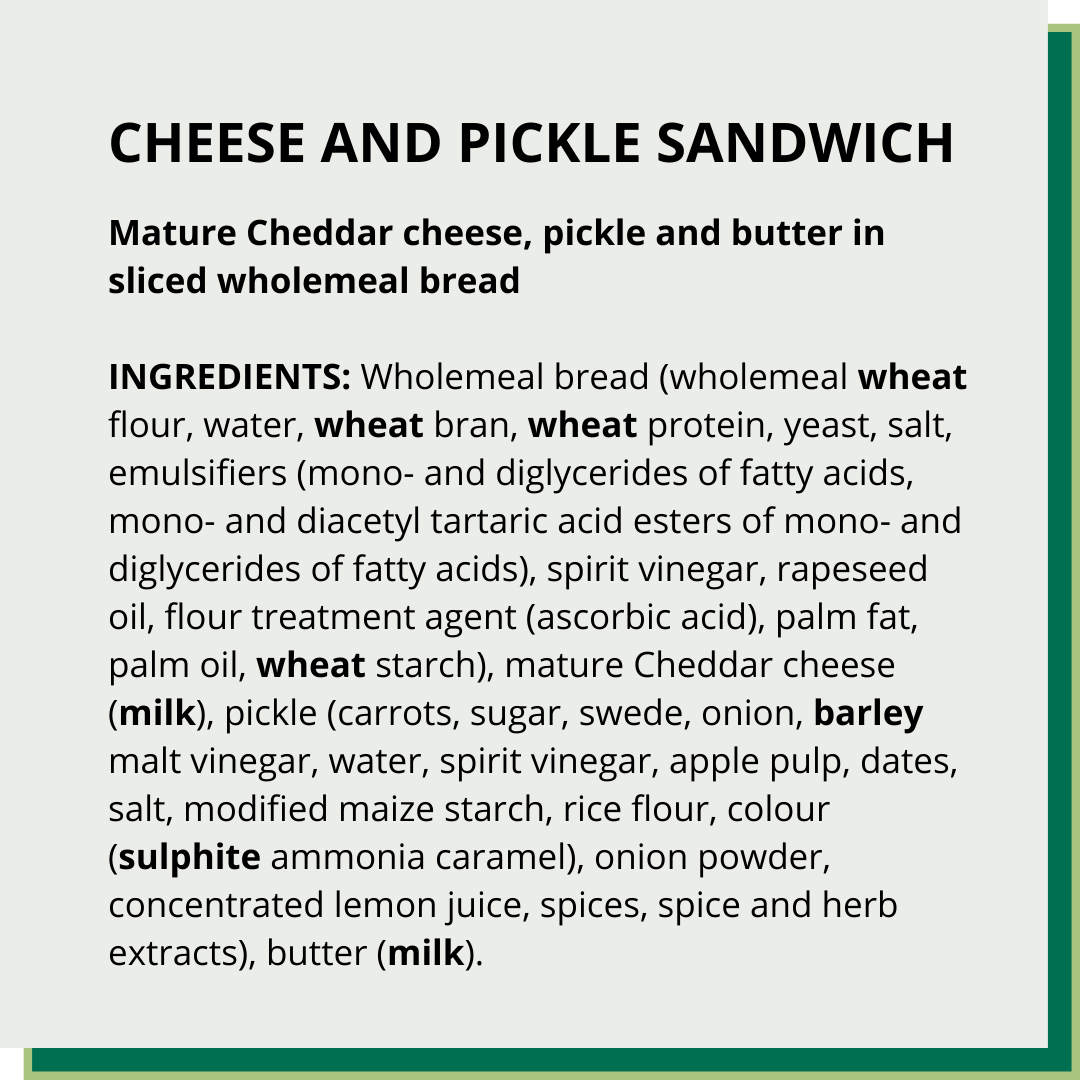Prepacked for direct sale (PPDS) allergen labelling changes for restaurants, cafés and pubs
Information for restaurants, cafés and pubs on the new allergen labelling for prepacked for direct sale (PPDS) food, also known as Natasha's Law.
From 1 October 2021 the requirements for labelling prepacked for direct sale (PPDS) food changed across the UK.
Also known as Natasha's Law, this applies to any food business that produces PPDS food, including coffee shops, restaurant chains, independent restaurants, supermarket and department store cafés, and pubs.
PPDS food is food that is packaged at the same place it is offered or sold to consumers. It is a single item, consisting of the food and its packaging, that is ready for presentation to the consumer before it is ordered or selected.
The changes mean that food packaged before the consumer orders or selects it, and sold on the same premises (or site where a business operates from more than one location such as a shopping centre) it is packaged at, will require labelling.
For restaurants, cafés and pubs, this may mean changes to labelling for foods such as pasties, soup, sandwiches, cakes and other products.
In this guide you will find examples of PPDS food commonly found in restaurants, cafés and pubs, as well as example labels and answers to frequently asked questions from the sector.

Changes to allergen labelling for restaurants and cafés
The changes to labelling requirements helps to protect consumers by providing potentially life-saving allergen information on packaging. This legislation is also known as Natasha’s Law.
Any food business that produces PPDS food will be required to label it with the name of the food and a full ingredients list. Allergenic ingredients must be emphasised within this list.
This can include food that consumers select themselves, for example from a display unit, as well as products kept behind a counter, or some food sold at mobile or temporary outlets.
Examples of food that is prepacked for direct sale
Examples of PPDS food that may be provided by a restaurant, café, pub or related food business include:
- prepacked paninis or boxes of pizza which can be reheated at the consumer’s request
- prepacked sandwiches or salad boxes
- pies in packaging
- soup already in pots.
Examples of food that is not prepacked for direct sale
PPDS does not include food that is not in packaging when the consumer orders it. Food made to order and food placed into packaging at the consumer's request is not PPDS.
Examples of foods that are not PPDS that may be provided by a restaurant, café, pub or related food business include:
- unpackaged cakes on display
- an open salad bar
- unpackaged complimentary bread placed on tables.
Non-prepacked (loose) food does not require a label and must meet current requirements for providing allergen information.
This means you must provide information on the 14 major allergens to consumers. You have some choice in how you provide this information to them.
Prepacked food
You may also sell pre-packaged food that was packed by another food business at a different site to where it is offered to consumers, or food that has been packaged by another business.
This is not prepacked for direct sale food, but it still requires a label with a name, ingredients list, allergens and other mandatory details.
We have further information on labelling prepacked food and the requirements food labels must meet.
Labelling guidance for restaurants, cafés and pubs
Labels on PPDS food need to show the name of the food and the ingredients list.
This includes emphasising in the ingredients list any of the 14 allergens used in the product, as required by food law.
Emphasis can be added by using bold type, capital letters, contrasting colours or underlined text. This must be clear enough for the consumer to read.
Our labelling guide for prepacked for direct sale food has detailed information on labelling requirements, including the name of the food, type size and precautionary allergen labelling such as ‘may contain’.

Labelling guidance for food sold online
The changes to labelling requirements do not apply to food sold by means of distance selling. This includes food that is purchased over the telephone or on the internet. If you sell food in this way you are already required to provide allergen information before food is ordered and when it is delivered.
Businesses may decide that it is easier to label all products rather than distinguish between distance and non-distance sales. This has the advantage that the business does not have to manage different information and labelling provisions.
We have further information on food sold through distance selling and the allergen information that must be provided in our Technical Guidance.
Example PPDS food label
Our labelling guide for PPDS food has detailed information on what to include on a food label, and how to present and produce it.
One example of how the label could look can be found below, but you could choose to present it differently as long as you meet the legal requirements. You must include the name of the food, a full ingredients list and emphasise any of the 14 allergens present in the food.

Definition of ‘packaging’
Food is PPDS if it is packaged as follows:
- the food is fully or partly enclosed by the packaging
- the food cannot be altered without opening or changing the packaging
- the food is ready for sale to the final consumer.
Examples of this kind of packaging would be:
- a cake packaged in cling film
- sandwiches placed in a paper bag with the bag folded over or twisted to encase the sandwiches
- rolls contained in a plastic bag that is tied with a knot or sealed.
Food is not PPDS if it does not have packaging, or if it is packaged in a way that the food can be altered without opening or changing the packaging (for example a burger served on an open cardboard tray).
Frequently asked questions from restaurants, cafés, and pubs about PPDS labelling
Where can I find the specific requirements for what to include on a PPDS food label?
Our labelling guide for prepacked for direct sale food has detailed information on labelling requirements, including the name of food, type size and precautionary allergen labelling such as ‘may contain’.
Do I need to change labels for food sold online or by telephone for collection and delivery?
The new labelling requirements do not apply to food sold by means of distance selling. This includes food that is purchased over the telephone or on the internet.
Businesses selling PPDS food this way will need to ensure that mandatory allergen information is available to the consumer before they purchase the product and also at the moment of delivery.
We have more information on labelling requirements for distance selling.

Do hot drinks, such as tea or coffee, require PPDS labelling?
Hot drinks made to order are not PPDS and do not require PPDS labelling.
But if you pour and lid drinks before consumers order them, in anticipation of a rush, the drinks would be PPDS and would need labelling.
Do I need to label individual food items wrapped in cling film?
If you have chosen to package individual items in cling film and it meets the definition of packaging (see above) then it is PPDS food and must be labelled.
Do I need to label food displayed under protective domes?
If the food under a dome is a single item, consisting of food and the packaging it is placed in, and it is ready for presentation to the consumer, then this is PPDS food.
If the dome is removed before the food is presented to the consumer then this is not PPDS, this is non-prepacked food.
As an example, if you have a sushi dish covered with a protective dome that is presented to the consumer with the dome on, this is PPDS food.
If you have a large cake under a dome, where the intention is to slice it into individual portions, and serve on a separate plate, this would not be PPDS as the large cake and the packaging it was stored in is not a ‘single item’. This is non-prepacked food.
Do I need to label food if I prepare and wrap food and keep it under a hot lamp before it is ordered?
If you prepack food in anticipation of consumer orders, these products will require PPDS labelling.
How do I correctly label food at a buffet?
Whether food at a hot counter or buffet is affected by the new rules depends on the specific set up.
The new PPDS rules apply to food that is packed before the consumer orders it at the site at which it is sold. If this is not the case, and the food is packed to order on site, or is not in packaging, the food is considered non-prepacked. If this is the case, existing allergen information requirements apply. You can provide this information by labelling the allergens contained in individual dishes for example, on menus, or by displaying a sign directing consumers to ask staff for allergen information.
If you offer food in the form of a buffet, you need to provide allergen information for each food item separately. You should not provide it for the buffet as a whole.
If the buffet food is prepacked before it has been ordered by the consumer, a full ingredient list is required to be provided directly on the product packaging or a label attached to the packaging with allergens emphasised within the ingredients list.
Does it make a difference to PPDS labelling requirements if the food is consumed on premises or taken away?
No, it does not make a difference. If the food is PPDS, labelling rules apply whether the consumer consumes it on premises or at another location.
How much detail do I need to provide when labelling compound ingredients?
A compound ingredient is an ingredient that is itself the product of more than one ingredient. For example, this could include bread in a sandwich, where the bread itself is made of various ingredients.
Naming compound ingredients in a list is not a requirement but can be done. For example, a sandwich label could include a list of the ingredients in the bread following the name ‘bread.’
If you chose not to list a compound ingredient under its own name, you will need to list all constituent ingredients of compound ingredients separately, in order of weight to the finished product as a whole.
Our labelling guide provides detailed information on compound ingredients and labelling prepacked for direct sale food.
Can food labels be handwritten?
Food labels can be handwritten as long as they meet the legal font size requirements. Labels on PPDS food need to show the name of the food and the ingredients list.
This includes emphasising within the ingredients list any of the 14 allergens used in the product, as required by food law. 'The allergens can be emphasised within the ingredients list by using bold type, capital letters, contrasting colours or underlined text.
Our labelling guide for PPDS food has detailed information on labelling requirements, including naming conventions, type size and precautionary allergen labelling such as ‘may contain’.
Revision log
Published: 9 July 2021
Last updated: 11 September 2023